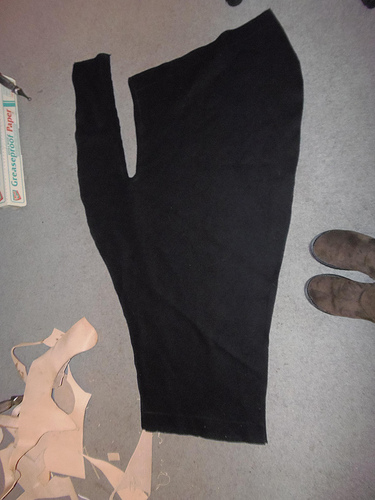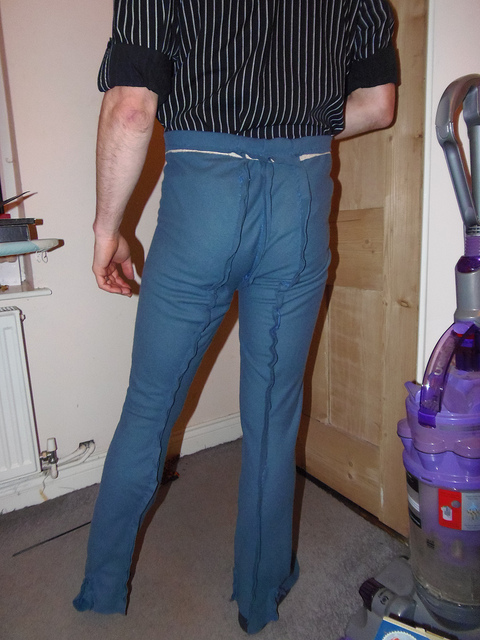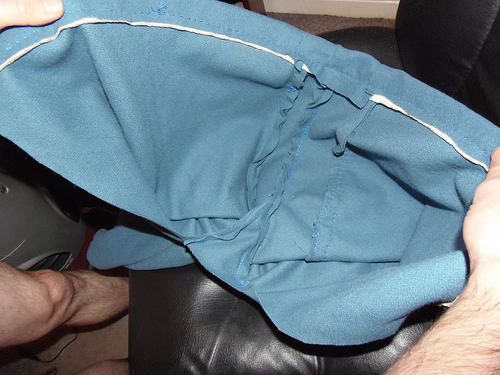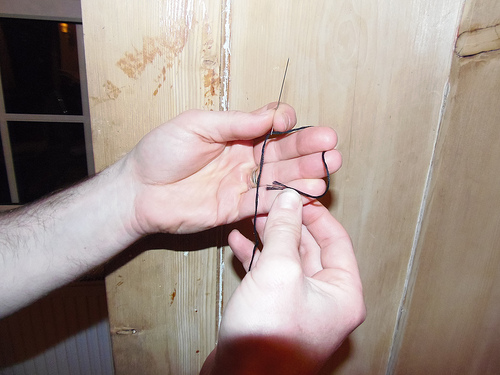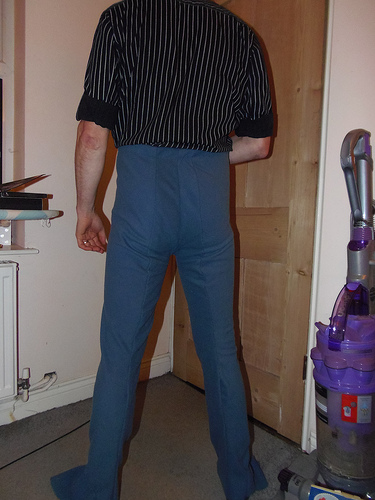A League costume diary
Dressing a Bravo
by Tim Baker
Part 1 - Planning and Design
Before I started I had a solid idea that I wanted my character to be a League bravo. He is going to be a professional soldier and instructor, with an interest in studying sword fighting as a science.
One of the key appeals of the League is the inspiration provided by the colourful outfits of late medieval mercenaries. Particularly the slashed doublets and hose of the Landsknechts.
What really sold me on the project was reading about those people and how they came to wear the clothes they did. If, like me, you have little knowledge of needlework and find the whole idea really intimidating, then this may be the project for you. Landsknechts were brutal professional soldiers with very limited tailoring skills. The fancy slashing is not just for show- it is to make up for the fact they didn’t really know how to sew.
Borrowed books and Google image searches turned up a lot of useful inspiration. I also came across a pattern I fancied using, which had got some good reviews from people I felt were reliable. I’ve never used a pattern before, but then I’ve also never taken on a major sewing project either (I’ve tried embroidery and leatherwork, but the most complex thing I’ve sewn until now has been a tabard).
Accessorising the costume will add some unique touches, but to start with I wanted to try making the key garments, particularly the ‘wams and hosen’ (doublet and hose).
IC and OC Practical considerations
The obvious starting point is that I like to play physically active characters and tend to be hard-wearing on my kit. Nothing in this costume should ever make me hesitate before jumping into a muddy ditch or pushing through a hedge.
I also want to be able to sit in a chair down at the tavern, sprawling comfortably. This should not be a costume that only works when standing elegantly like a courtier.
As of writing, I still don’t know what weapons or armour I want to use on the battlefield. My guiding principle here is that if the costume is based on a historical one, it’ll probably work just fine with whatever I settle on.
One great thing about late medieval mercenaries is that they were really well documented (relatively). Flamboyant costumes contrast with practical and brutal lifestyles. These were people who were ordered to have ‘regulation length’ pikes, but who invariably sawed four feet off the end to make them easier to carry. People who were notorious brawlers and thugs, but whose style influenced fashion across a continent.
The main consideration this gives me is quite a convenient one: nothing I’m carrying should be utterly impractical. These bravos are not the armoured knights of Dawn who might change clothes completely before battle, don padding, then carefully strap on each piece of plate. Rather than separate padding, a landsknecht might own a ‘ledergollar’- a leather waistcoat that could be either light armour in its own right or padding for a breastplate. Otherwise I should be ready to fight in the clothes I’m swaggering around in. All of that fits well with the kind of character I have in mind.
The slashing in the fabric achieves two purposes. For one, it allows someone with no taste or restraint to show off their gaudy colours. Secondly, it allows movement. A skilled tailor can make hose which sit very tight but allow you flexibility. The slashing lets you move even in hose that were made by a ham-fisted thug (like me!).
A final practical point is that I want to be comfortable in all weathers, so options for making this cooler or warmer are ideal.
Breakdown, layer by layer
On my legs I plan to wear slashed hosen. There will be two layers. One pair of tight fitting hose underneath, which will not be slashed. Over the top will be a second pair of hose, with the slashes to show the pair underneath.
For my torso, I will be wearing a doublet. This will have a wide neck (I often think these wide necklines, rather than a close fitting collar, are an iconic feature that sets this outfit apart from an earlier medieval look), to show the shirt underneath. This doublet will have an option to lace on a rectangle of richer material over the chest, called a brustfleck. When reading up on the costume I saw that the brustfleck was often made of something expensive which a landsknecht had taken as plunder, to show their success in battle. I feel this fits the character, so decided to add it in.
Once the rest are made, I plan to work on a ledergollar, partially so I can have some lightweight brawling and training armour and partially to pad my breastplate if I choose to wear one. However, this will have to wait until the doublet is done to be able to measure it up.
For footwear, I am currently undecided. Once hose are complete I will see how different options look. The pattern allows for the hose to have integral feet, which works well with a classic 1500s lightweight shoe, but I tried some on and found them less than comfortable. Once the hose are done I’ll try some options.
Accessories
There are a few things which leap out from the League brief and historical inspirations. One I am keen to try is tying ribbons around my limbs. This is to serve a dual purpose of decoration and also holding folds in the fabric in place at key places around my joints.
A mask motif might also make an appearance- I like the idea of having a mask hanging from the belt, ready for use if needed (this is entirely the fault of Ian Andrews’ book ‘The Pearls That Were His Eyes’).
Fabric and materials
This is an important bit. Hose need to be cut on the bias to give them enough stretch when you move. However, landsknechts did not hem the slashes in their clothing- they just used fabric which would not fray when it was cut.
Therefore I have gone for some different types of wool for this outfit. The first pair of hose, worn next to my skin, are of a soft blue wool with a lot of stretch (£8/m), bought from Herts Fabrics. The hose on top, which will be slashed, are of a heavier black wool (£11/m), a melton type, bought from Anne Laverick. Tests with the black wool confirm that it does not need hemming and will not fray, but does not stretch as much as the blue.
For the doublet I will be using the same wools, although the properties are not as critical here. Having said that, the heavier wool will be ideal if I want to wear plate armour on my upper arms, seen quite often in illustrations.
For the brustfleck I’ve bought a small deer skin (15 Euros) from a re-enactment market near Paris. This will be the lining and give it a lot of depth- thus achieving the desired look of a manly, well developed chest. To line the ledergollar I will either be using silk (Herts Fabrics, £5/m when he was having a sale some years back) or linen, with a very soft leather cover (Lyon Leathers). The key here is that the collar will be against my neck and I don’t want it to chafe. Keith Lyon provided valuable advice here and was very worth speaking to.
So what do I need?
Fabric
Part 2- Making it
The Pattern
I am using a pattern by Reconstructing History- ‘RH502, Landsknecht Wams and Hosen’ bought from Paul Meekins Books for £24. Thus far, worth every penny.
My starting point here is as someone who cannot easily use a sewing machine and doesn’t really know any stitching techniques- my method to date has been ‘go in-and-out until it hopefully stays together’. Thankfully, the RH pattern book also has clear and easy instructions on how to do some useful types of stitches. As a small confession, I’m slightly scared of needles, which puts me off sewing machines and is one reason I’m hand sewing everything (I am happier when I feel I can control the evil thing). On the bright side, this is allowing me to pay particular attention to key areas where I know the fabric will be stressed.
Thus far I am finding the pattern is not perfect, but I’d be shocked if it was, but seems to be making what seemed like an intimidating task quite manageable.
Garment 1: Under-hose
First off, I used some grease-proof paper to trace out a copy of the pattern pieces. Not being confident in my skills, I don’t want to ruin the original by cutting it up.
Once this was done, I laid the pattern out on my fabric, sitting diagonally across it (on the bias). This is done to ensure you will get as much stretch as posisble. Despite not having made a pair of hose before, I’ve been wearing them at re-enactment for more than 18 years now and the most common problem is them tearing across the crotch. Knowing this, I plan to try and stop it happening by every means possible.
A carpenter once told me ‘measure twice, cut once’. That is worth applying here. Once your pattern is laid out, draw around it on the fabric with dressmakers chalk. When you cut around it, remember to leave about half an inch all around as a seam allowance. You can always cut more off later if you make it too big.
A key feature of these hose is where they sit on your waist. Modern trousers usually come up to around your belly button, while the more common mid-15th Century hose sit very low- barely covering your bum when standing. These landsknecht hose come up much higher, with the top almost up to your ribcage. I am guessing that this might have been to make their legs look longer, but really have no concrete idea.
As another word of advice, bear in mind that the leg seams on hose do not sit in the place you would expect with modern trousers. Rather than a seam up each side of the leg, you have just one seam running up the back.
The pattern gives you a choice of two ways to do your seam, with either what they call a ‘classic seam’ or a ‘slanted Italianate seam’. I chose to go with the former, as it looked easier.
Having cut out twice around the pattern (once each way up), the next stage is to pin them and have a look at how they fit around your legs, then pin the two sections together. A friend to help you in invaluable here. Once they are pinned in approximately the right place, loosely stitch them together.
Wearing the hose inside out to be able to adjust the seams.
For this stage, I was just wearing them inside out, so I could see all the seams. It was also the stage where I made my first big mistake.
Mistake 1: sewing the wrong side out
I had sewn up each leg and they seemed to be fitting well. I then started to sew the two legs together. When I tried them on again, I realised that I had stitched the crotch seam the wrong way around, so if the seams on the legs were hidden that one would show, or vice-versa. There was nothing for it but to unpick that seam and do it again. Still, it didn’t take long and was a good exercise in why it is worth doing a rubbishy loose stitch first, then going over it with a better one when you are sure the fit is right.
However, I did take this opportunity to make what I consider to be an improvement to the pattern. Time will show if I am right
Improvement: the gusset
At the bottom of each ankle you need to make two small slits (one each side, over the knobbly bits of bone that stick out). These slits allow you to insert triangles (gussets), which thus slightly flare the bottom few inches of the material and make it fit better over your feet.
To be honest, I was having a bit of a whine about this bit, as it seemed like extra work for marginal benefit. Having done so though, I recommend doing the same and they do fit better and it didn’t take long. If you are making hose which cover your feet this bit is particularly important, but I’d do it either way.
Anyway, having cut out four triangular gussets anyway, I spontaneously decided to cut out a fifth one, slightly larger than the others. Bearing in mind how often I have seen hose split across the crotch before, I added this extra gusset between the legs. It isn’t in the pattern, but it should add a bit of extra room to maneuver. A 10 minute job that adds a lot of confidence to the end result.
Here you can see both the triangular gusset I’ve added to allow movement between the legs and the linen insert peeking out of the waistband where it has been stitched in to add strength.
Stitching up
Once I was comfortable everything was about right, I did my final stitching together. For most of the back of the legs I just used a conventional [running stitch], although trying to keep the stitches small for neatness and strength. However, for the crotch seams and gussets I used another seam (with instructions from the pattern book)- the [backstitch]. This is a dead easy stitch to do, but seems really strong and good for reinforcing those vulnerable areas.
One other decision I made may have been slightly bizarre, but we’ll see if it worked out: to stitch the seams I used a large-ish needle and embroidery thread (as in, several strands, not just a single piece), rather than cotton. This was another choice to try and increase the strength of the seams.
Needle with embroidery thread
Handy Tip from Helly
By sheer luck, the excellent Helly Bean happened to be down when I started this project. She is a much more experienced seamstress and offered a really useful bit of advice: when lining up your seams, be careful not to stretch one side of the material more than the other. if you do, it will distort the fabric. I have tried to follow this throughout the process by carefully smoothing out the material before I sew, to ensure both sides are lying naturally so there is no distortion.
Improvement 2: Lining the waistband
This is something else I decided to do based on my experience of wearing hose at re-enactment. Hose are normally laced to the doublet, which holds them up. However, the points where you have laced them can come under a hell of a lot of strain when you are moving, especially if you are active. Many are the times when I have been fighting and felt a lace go ‘ping’ deep under my armour and known there is now nothing holding my hose and nothing I can do about it either.
Worse than a lace snapping is if the material of the doublet or hose tears. Then you can’t just put a new lace in and the repair is a real swine to do in the field. To try and prevent this, I folded over the wool at the top of the hose to make a waistband. Between the two layers of wool I inserted a heavy linen strip, then sewed it in. Hopefully this will stop it tearing if I roll around the place.
Problem 2: Feet
I was in two minds as to whether to make feet for these hose, but decided to give it a try. It was when I had cut out and pinned the soles that I discovered a problem: when the feet were attached, it tended to pull the hose down and make the crotch sag. Not much, but just enough that it might make them more prone to tearing.
Thus the current plan is to remove the spats (top of foot) and just make them hose without feet, as these will most likely be covered by boots anyway.
Here you can see the seam running at the back of the legs, as well as the unusually high waist.
Garment 2: Outer Hose
If you don’t plan to wear slashed hose, these are unnecessary. You just wear the under-hose as a complete garment. However, whichever pair is on the outside will need a codpiece.
For these, I started in the same way as with the under-hose. However, they need to be slightly bigger in order to fit on top.
Problem: My poor decision making
When I bought the material, I had a very limited choice of colours. This was primarily because I was being very picky about the physical characteristics of the fabric (stretch, resistance to fraying etc). I also wanted a contrast between the outer and inner layers.
Thus I decided to make my outer layer black, with something colourful on the inside. It was only when I came to start sewing that I realised the obvious problem. Black thread against a dense black fabric is really, really hard to see properly. Thus I found sewing this to be a bit slower than sewing up the blue under-hose. Still, if you want black it shouldn’t stop you- just be aware it may take a few minutes longer.
Marking out the slashes
At this stage, before sewing the seams up the back of the legs, you are supposed to put in the slashes where you want them. This stage takes a bit of planning, as it will affect the finished look. Again, the pattern book is invaluable here, as it gives some good advice. In particular, using a spare off-cut of fabric to do some testing. Normally I am the kind of person who doesn’t bother with such things (like not testing hair dye on a patch of my skin before using it), as I’m too impatient. In this case I was glad I did. My first couple of slashes into the test fabric went slightly awry before I got the knack for cutting straight, but very quickly it got easier. For the sake of five minutes and a bit of throwaway material this was very worthwhile.
However, I chose to deviate from the pattern book a bit at this stage. Because I want my hose to be fairly tight to my legs, I didn’t want the slashes in before I had stitched them. That way they would be very close fitting and the slashes would add extra flexibility. Thus I marked with chalk where I wanted the slashes, but held off cutting them in until the next stage was done.
The pattern book offers several options for types of slashing you can use at this stage. To be quite frank I didn’t fully understand all of them, so went for the one it said was most common and where it was clearest what to do- alternating horizontal and vertical slashing.
Stitching Up Again
The pattern book had advised that the best way to get your seams right was to loosely sew them up using a ‘basting stitch’. This is just a really quick and dirty way of sewing where the stitches are about half an inch apart. Very little strength to it and you’d never rely on it to hold clothing together (unless you wanted to be undressed while fighting for comic effect). For the under-hose I hadn’t bothered, because the wool was lighter, so pins seemed to do an OK job of holding it together while I worked out where the proper seam should go. However, the outer hose are made of the heavy, fray-resisting, melton wool- pins fall out under the weight far too easily. Here the basting stitches were a god-send, because they allowed me to try the hose on, mark a few places where they needed tightening with dressmakers chalk, then do the final stitching. In hindsight, it was so much easier that I probably should have followed the pattern’s advice for both pairs.
Cutting the Slashes
Now that the legs were stitched up and I was happy with the fit, I started to cut in the slashes. Slightly slowed down by the compulsion to try them on once the first leg was done.
First look suggests that I could have put more slashing in each row, but to start with I held back a bit on the basis that you could always cut more later, but you couldn’t take it back. Initially I used scissors to cut in the slashes, but soon found that a sharp knife was quicker and gave much better control.
Codpiece and Gussets
Having what now looks largely like a pair of hose, once again I added a gusset between the legs and this time made up a codpiece. For the codpiece, I chose to make it out of two layers of wool, with the liner being the same blue as the inner hose. My thinking was the slash the black outer to show the blue, but thus far it doesn’t seem to really work, in that because the codpiece flexes less than the legs, the blue doesn’t show through.
The codpiece was where I found the greatest number of problems in the whole project. The pattern suggests options for having a single thickness of material, lining the codpiece or even for padding it(!). I chose lining as I tend to think lining makes garments look like much better quality, while padding would have been a whole different statement than I wanted to make for the character. However, my choice soon proved fraught with problems. Once I had the codpiece stitched on, I immediately found the material was bunching up between my legs. To make a lined codpiece, I'd laid the two layers of material atop another, then stitched them flat. Having done this, I turned them inside out so the rough edges of the fabric and the stitches wouldn't show. This looked neat, but had the side effect of making the edges bulky. Stitched into the gusset between the legs, the effect was amplified and felt frankly ridiculous as well as uncomfortable- a huge wedge of material between the upper thighs. In practice I’m not sure it was visible, but it had to go.
My eventual fix was to unstitch the bottom half of the codpiece and cut away the liner, so only the front section is lined. It is now more comfortable, but still has the lined appearance.
Pointing
To make everything stay on, a series of reinforced holes (points) had to be made in the hose. These are where they will be laced to the doublet to hold them up, as well as how the codpiece will be held in place and the flies held together. It is probably the most laborious part of the job, although not complicated. A minimum of 14 holes will be needed, probably more. Each of those has to be made by pushing something round like a thick awl through the material to make a round hole, then sewing around and around the edge to keep it open and strengthen it to stop laces tearing through the fabric. It is important when making the hole not to cut the fabric, as that will make it fray or tear, but to push the fibres apart around whatever tool you are using.
The problem here is that they can take about five to ten minutes each, even with a bit of practice, which equates to a lot of very dull sewing. It’s worth doing though, to make the hose last longer and more comfortable- just get a couple of good dvds to watch for an evening.
Final adjustments
Trying the hose on properly, it was obvious that the top of both leg seams needed tightening. Being too loose, especially with such a high waist, made my backside look massive. This was trivially fixed though. It is also apparent that I could stand to extend some of the slashes to make the colour more visible.
Possible shortcut
It occured to me after I made the under hose that I could have cheated to save a lot of time by wearing a pair of coloured leggings under the wool outer hose, rather than the under-hose, since their primary purpose is to provide splashes of colour seen through the slashes. If you are on a budget, this may also save money (two metres of good wool will almost always cost a lot more than a pair of cheap leggings).
Next: Doublet (coming soon I hope)
